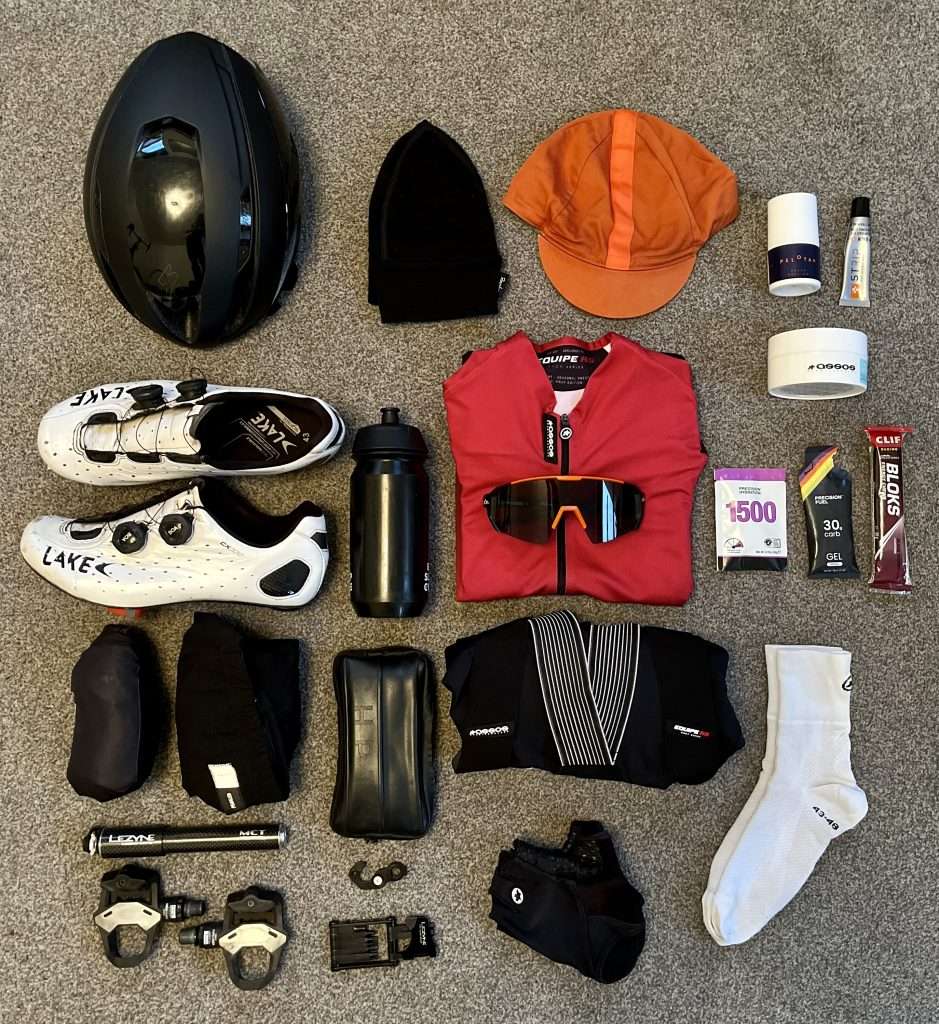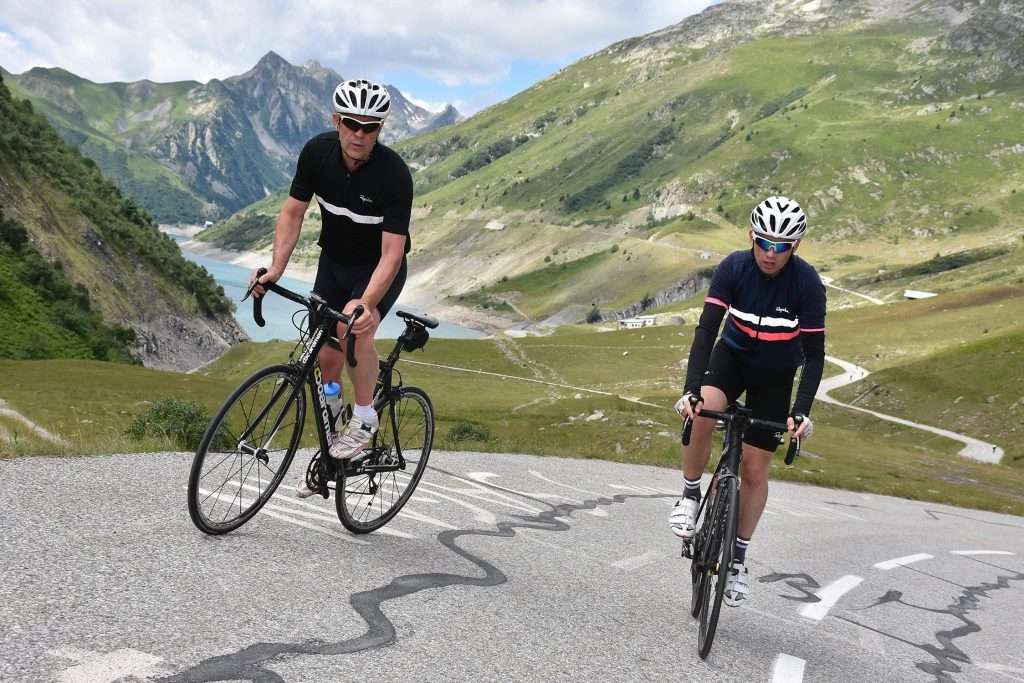As we look forward to Port Velos French Alps Cycling Tour, this September, it’s worth considering how challenging cycling at altitude can be. Here is some advice on how to conquer riding at altitude.
There are so many reasons to ride the fabled climbs of your hero’s, from the achievement of reaching the summit or just getting to the top to take in the amazing views they offer. From Mont Ventoux, Alpe d’Huez to Col de L’Iseran, the mountains can be challenging and it’s important to be prepared before you tackle the legendary European cols whenever you decide to ride them.
| Key Takeaway | Details |
|---|---|
| Effects of High Altitude | Thinner air leads to less oxygen, increasing heart rate and making cycling feel harder. |
| Nutritional Needs | Prioritize carbohydrates; carry electrolyte drinks and snacks to maintain energy. |
| Hydration | Stay hydrated despite feeling less sweaty; altitude increases water loss through respiration. |
| Descending Safety | Be cautious on descents; energy stores may be depleted, and road conditions can be unpredictable. |
| Breathing Techniques | Practice diaphragmatic breathing to increase lung capacity; breathe faster to improve oxygen intake. |
| Power Output Adjustment | Accept that power output may decrease at altitude; pace yourself based on feel, not numbers. |
| Sleep Quality | Sleep can be disrupted at altitude; prioritize recovery and avoid overexertion. |
| Appropriate Clothing | Prepare for temperature swings; pack layers and sun protection. |
| Safety Measures | Be visible, check weather, plan for emergencies, and carry necessary tools and ID. |
| Training for Altitude | Simulate low cadence riding and hill climbs to prepare for the demands of high-altitude cycling. |
1 THE EFFECTS OF HIGH ALTITUDE
Preparation is so important, especially riding at altitude. You will need to put in the training and you’ll reap the rewards. We know that air is thinner at altitude, what this means is that the molecules of oxygen, nitrogen and carbon dioxide that makes up air, are further apart. It means that for each each breath, there are fewer of each molecule, and crucially less oxygen for energy production.
The effects of altitude start quickly, with the amount of oxygen in the blood dropping almost as soon as you start the mountain. Above 1500m the air is thinner and makes cycling feel harder because in part that to maintain the same power output your heart rate will be 10 to 20 bpm higher.
2 NUTRITIONAL NEEDS
When you ride a long distance at altitude for example in the French Alps, there are physiological changes to be aware of.
As we have less oxygen available the bodies response is to prioritise carbohydrates for energy during exercise. We only have so many carbohydrates available so we have to top up frequently. We recommend taking two 750ml bottles filled with a carb/electrolyte drink and keep spare sachets in your pocket. On the Port Velo tours we will always have, where possible a support vehicle with backup nutrition and fluids because we understand the needs of cyclists on this type of terrain.
3 HYDRATION

When you think of cycling in the mountain air, you might think you sweat less, but it’s important to keep drinking. Against a common misconception, altitude causes dehydration through a diuretic effect, plus you lose more water vapour via breath at high altitude as the air is typically drier. Cycling long climbs means you are working harder and sweating, with less convective heat loss, which increases core temperature and salt loss.
4 DESCENDING
It’s not always about the climb, part of why we love the challenge of the climb is the descent. In theory you’ll be quicker on the descent as the lower oxygen pressure at altitude means the air is thinner. But you need to remember that you’ll have depleted energy stores and riding at altitude is harder, so be sensible if the descent is fast and furious. Don’t take risks on the high Alpine passes.
The roads are specially prepared for the professional riders before big events like the Tour de France but for the rest of the year, there can be gravel on corners, damaged road surfaces after the winter snow, and even animals crossing.
5 BETTER BREATHING
When we are riding up the climbs at altitude, or at sea level we tend to increase our rate and depth of breathing. This is to get more oxygen into the blood system.
This starts almost instantly when riding at altitude but can be reduced when you start to acclimatise. A good way to prepare for this is to practise diaphragmatic (belly) exercises at home before exercising, this can also help increase lung capacity. Finally, breathing a little faster when at altitude will assist in getting more oxygen into the lungs and by default into the blood stream
6 POWER OUTPUT
If you usually train to power using a power meter and are unfamiliar with riding at altitude, you will need to accept that you won’t be able to immediately produce the same numbers as the road rises upwards and at higher altitude.
As I mentioned earlier, the advice is to adjust your effort and pace yourself on feel rather than numbers. This also applies when dealing with switchbacks at high altitude: one minute you might have a tailwind and overdo it, before swinging back into a headwind and feeling empty. Try to ride at a continuous effort.
7 SLEEP WELL
It will take a few days for your body to become accustomed to altitude and a good nights sleep. The quality of sleep can be reduced at altitude, particularly for riders not well acclimatised. It’s important to ensure you’re recovering well from hard efforts at altitude, so you don’t overreach. If you’re on a multi-day altitude ride, which our French Alps Tour is, it advisable to try and do less than you normally would in the evenings to conserve energy, by doing things such as taking the lift instead of the stairs, for example. It’s best to avoid alcohol too but that’s easier said than done on your cycling holiday!
8 WHAT WEAR
Riding at altitude will see you deal with extremes of heat and cold in the same ride. Temperatures can swing 30°C between valleys and summits, so think about your clothing.
Thermal arm warmers and a lightweight jacket/gilet can be stored in your jersey pockets. On our tours you’ll be riding as part of a group with a support vehicle, so you can pack bigger items of clothing in a day bag.
Also ensure that you’re re-applying sun cream frequently: it’s easy to forget when the air’s cold.
If your still unsure what to pack, check out our article Ultimate Cycling Holiday Packing Guide

9 RIDE SAFELY
Another way to conquer riding at altitude is being prepared. This will give you peace of mind and more confidence in the mountains. Follow these simple steps…
- Be visible take a back light so vehicles can see you better in tunnels and low visibility.
- Check the weather forecast, wear sunscreen and take appropriate layers.
- Plan for bad weather Remember that the forecast can change at altitude – temperatures decrease as you get higher by around 1°C for every 100m.
- Take tubes and tools Ensure you have adequate spares and tools for adjustments or repairs.
- Pocket your phone Always take ID, next-of-kin details, a phone and a credit card, just in case you have an accident or major mechanical issue.
10 TRAINING
If you don’t live at altitude then it’s quite hard to train for it. However there are some sessions you can do. You can simulate the low cadence of high altitude at home on flat, windy roads. Climbing tends to generate high crank torque, so at home get into a big gear and do sets of low-cadence (60-70 rpm) riding at zone 3 level.
You could also climb a 10min hill six times at a steady pace to simulate a longer climb.
Check out our article on how to ride up hills faster on your bike
FAQ
1. What are the main effects of high altitude on cycling performance?
Cycling at high altitude can lead to decreased oxygen availability, which affects energy production. Riders may experience increased heart rates and fatigue due to the thinner air, making it essential to acclimatise and adjust training accordingly.
2. How should I adjust my nutrition for cycling at altitude?
At altitude, prioritise carbohydrates for energy since the body requires more due to reduced oxygen levels. It is recommended to carry electrolyte drinks and snacks to maintain energy levels throughout the ride.
3. Is hydration still important at high altitude?
Yes, hydration is crucial even if you feel you sweat less. The air is drier at altitude, leading to increased water loss through respiration. Regularly drinking fluids is necessary to prevent dehydration.
4. What precautions should I take when descending at altitude?
When descending, be cautious as energy stores may be depleted. The thinner air can make descents feel faster, so it’s important to ride sensibly, avoiding risks from road conditions or sudden obstacles.
5. How can I improve my breathing while cycling at altitude?
Practicing diaphragmatic breathing exercises which can enhance lung capacity and oxygen intake. During rides, focus on maintaining a steady and slightly faster breathing rate to maximize oxygen absorption.
6. What should I wear for cycling in the mountains?
Dress in layers to accommodate temperature fluctuations. Lightweight jackets, arm warmers, and sun protection are essential. Always be prepared for changing weather conditions.
7. How can I train effectively for cycling at altitude if I live at sea level?
While it’s challenging to simulate high altitude training, you can focus on low-cadence riding and hill repeats to build strength and endurance. Incorporate specific workouts that mimic the demands of climbing.
8. What should I do if I experience altitude sickness?
If you feel symptoms of altitude sickness, such as headaches or nausea, it’s crucial to descend to a lower altitude and rest. Hydration and avoiding strenuous activity can also help alleviate symptoms.
9. How important is sleep when cycling at altitude?
Quality sleep is vital for recovery, especially at altitude where sleep can be disrupted. Ensure you get adequate rest to help your body acclimatise and recover from rides.
10. What safety measures should I take while cycling at altitude?
Always carry essential tools, spare tubes, and a phone for emergencies. Check weather conditions before heading out, and inform someone of your route and expected return time.


Leave a Reply